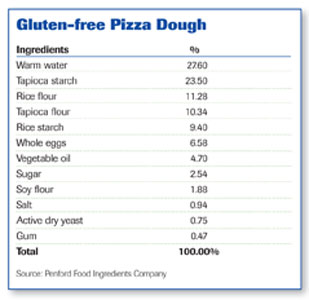The rice hull contains less than 3% protein and less than 1% fat. The carbohydrates it contains are cellulose, crude fiber and hemicellulose. As a silicon dioxide replacer, rice hulls are beneficial in spices, beverages, dry mixes, dried fruit and dried honey. In tea bags, rice hulls carry the flavor and can replace maltodextrin.
Steve Peirce, president, RIBUS Inc., explained, the “rice bran requires stabilization, but it is a source of fat, protein, and other nutrients, including antioxidants,” during his presentation titled, “Rice Byproducts Provide Natural Functionality,” given at Prepared Foods’ 2009 R&D Applications Seminar-East. The polar characteristics of the glycolipids are what enhance bakery products, sauces, spreads and extruded products, when they replace lecithin and mono- and diglycerides. “Rice bran can also be utilized as a surfactant or hydration aid in supplements, protein powders, gums and difficult-to-hydrate powders,” he added.
The broken white rice is made into flour, starch, syrup, protein and maltodextrin. Rice flour is often a major component of gluten-free baked goods. For labeling purposes, rice flour is gluten-free and allergen-free. Rice flour, starch and emulsifiers are all important ingredients for gluten-free applications. The emulsifier acts as an oil binder, adds texture, aids in hydration and enhances freeze/thaw stability.
In nut butters, rice bran extract is used to emulsify the oil, and the rice hulls absorb oil. It provides for a clean label, creamy texture and no oil separation. When seeking functionality, developers should consider the clean label alternative in rice byproducts.
“Rice Byproducts Provide Natural Functionality,” Steve Peirce, president, RIBUS Inc., steve@ribus.com, www.ribus.com
—Summary by Elizabeth Mannie, Contributing Editor
The Effectiveness of Starches in Gluten-free Applications
Gluten intolerance and celiac disease are among the most under-diagnosed chronic health conditions. An autoimmune disorder, the only available treatment is avoidance of gluten in the diet. Gluten is found in wheat, rye, barley and spelt. A growing health concern, the gluten-free market has grown at an average rate of 29% since 2004, with 66% of sales in traditional retail channels. Globally, 15 million consumers are gluten-intolerant. Three million U.S. consumers remain undiagnosed, which is 6-8% of the U.S. population.

|
|
Two different types of tapioca starch help attain a desired end-product, providing a better crust with more height, open structure and desirable golden color. |
“The real market opportunity is not just celiacs, but their families, as well,” said Bryan Scherer, director, R&D, Penford Food Ingredients Company, during his presentation, “Effectiveness of Starches in Gluten-free Applications.” However, there are development challenges with replacing gluten in baked foods.
Gluten is a composite of the proteins gliaden and glutenin. These proteins, along with starch, are found in the endosperm of cereal grains, such as wheat, rye and barley. When dough is kneaded, glutenin cross-links with itself and then associates with gliadin to form gluten strands. This is what provides the viscosity and elasticity to dough. The more kneading, the more gluten development, and the chewier the texture, such as in bagels and pizza crust. With less kneading and less gluten development, more tender breads are formed.
In leavened products, the gluten network traps carbon dioxide bubbles and enables the dough to swell or rise. Stabilization happens when baking the dough coagulates the gluten. Along with the starch, this stabilizes the structure and texture of the finished product. Difficult to accomplish without gluten, broad market acceptance means products must have the organoleptic attributes of a full-gluten product. Other concerns are cross-contamination of ingredients, if they are processed in facilities that process gluten-containing ingredients. Opportunities for processing at true gluten-free facilities are limited.
Scherer explained, “Starches work synergistically with one another and other protein sources to create the ideal texture and chewiness.” Starches deliver superior bakery products without gluten that provide chewy texture, enhanced volume, open cell structure, tender bite and a moist texture.
Consumers are looking for solutions and sources for gluten-free products. Blogs, websites and guides are emerging to help communicate restaurant offerings. Real wheat-free menu solutions help to increase restaurant traffic. The opportunity for foodservice operators is to provide celiac consumers with foods they enjoy, rather than losing all customers in that individual’s dining group by not providing appetizing gluten-free solutions. For example, certain consumers were thrilled when UNO Chicago Grill recently started offering gluten-free pizza at almost all of their locations.
In summary, 15-20 million people are affected by gluten intolerance. Symptoms are triggered by the consumption of gluten protein found in wheat, rye, barley and spelt. Living with gluten in the diet is not an option, and gluten-free products must have culinary appeal. Gluten is critical in baked goods, but it can be replaced to achieve the organoleptic properties consumers want. However, solutions must be tailor-made. It is not a one-starch solution. It is important to understand how various starches interact with other ingredients, in order to deliver the desired end product. In addition to the bakery category, starches can also solve gluten-free challenges in coatings and breading systems. pf
“Effectiveness of Starches in Gluten-free Applications,” Bryan Scherer, director, research and development, Penford Food Ingredients Company, bscherer@penx.com, www.penfordfoods.com
—Summary by Elizabeth Mannie, Contributing Editor
